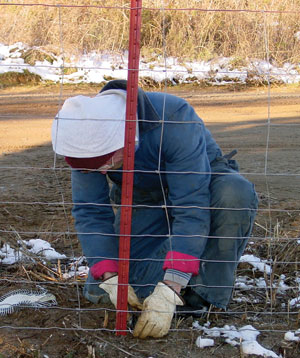Fencing
Often the cost of fencing is a major limitation to using goats for vegetation management. Sometimes existing fences can be modified cheaply to contain goats. Both conventional fence and electric fencing can be effectively used to fence goats, but the use of electric fence requires a commitment to fence maintenance that some managers cannot make. Problems can occur with existing field fence that is a net-wire type with only 6 inches between vertical strands. Goats will be able to push their heads through the fence but cannot pull their head back through because the horns get caught. The goat will remain trapped in the fence until the manager frees it, a predator eats it or it dies. To prevent this problem in short sections of fence, every other vertical strand of wire can be clipped with wire cutters. The most workable remedy is installation of several strands of electric fence in front of the net wire to prevent goats from reaching it or the complete removal of field fence and installation of more suitable goat fencing. More information on fencing can be found in the Goat Facilities section.
If five-strand barbed-wire fencing is present, there are several alternatives which are covered in more detail in a Langston University publication on fencing. Two or three strands of barbed wire can be added to the lower part of the fence with stay wires between posts. Goats most commonly escape by going under a fence, so ensure that the lowest strand of wire is within 7 inches of the ground. Washes, water gaps and wildlife trails under fences need special attention. Modifying a barbed-wire fence in this fashion is fairly cost effective but requires significant labor. Another alternative is to use one or two strands of electric fence low to the ground, about 1 foot in front of a five-strand barbed- wire fence. Step-in posts or fiberglass, sucker-rod posts can be used. Stand-off insulators work well but tend to be expensive. Solar powered chargers can work well in remote areas, although they are less powerful and more expensive for the same output as plug-in fence chargers. A plug-in fence charger is more reliable than a solar unit and should be used if possible.

If no fence is present, goat net-wire fence can be installed. This type of fencing is called 10-47-12 Sheep and Goat Wire. It has 10 horizontal strands, is 47 inches high and has a 12-inch spacing of vertical wires. There are two versions of this fence: a standard low-tensile type that is easily bent and a newer, high-tensile version in which the wire is difficult to bend and will to some extent spring back to its original shape. This high-tensile version offers the advantage of retaining its shape if something moderately heavy, such as tree branches, falls on it. Installing high-tensile fence requires more skill than the conventional version, and corner posts must be well set. A new 12.5 gauge high-tensile woven wire that has a 24-inch vertical spacing is now available. It is 36 inches tall and can have either five, seven, nine or eleven horizontal wires. It is generally less expensive than conventional woven wire. Horned goats usually do not get caught in the woven wire fences with vertical spacing greater than 6 inches, or, if caught, they are able to free themselves because of the larger opening.
Electric fencing is another option for goat producers. Four strands of electric fence 30-inches high have been proven to effectively hold goats. Some producers have used only three strands, but this is less secure. A variety of posts and insulators are available. There are three rules for the successful use of electric fence: 1)install correctly using quality materials; 2) train animals to the fence; and 3) check the fence voltage every day. Find someone who has successfully used electric fence to assist with selection of materials and provide proper construction techniques and recommendations. Animals can be trained to an electric fence by having the electric fence across the corner of a trap or pen that is goat proof. Another method of training goats to an electric fence is to suspend aluminum soft drink cans on the fence from top to bottom. Dipping it in molasses is optional. The cans will attract curious goats to test the fence, and they will learn to respect it. By checking the fence daily to ensure a current of at least 4,500 volts, problems will be found and fixed before animals discover the fence is not hot and escape.
Hart, S. 2006. Goats for Vegetation Management. In: Meat Goat Production Handbook, ed. T.A. Gipson, R.C. Merkel, K. Williams, and T. Sahlu, Langston University, ISBN 1-880667-04-5.
